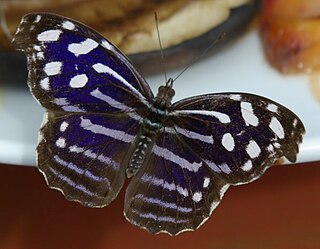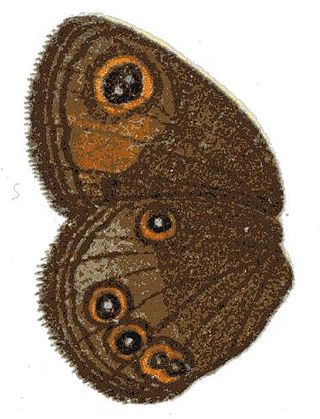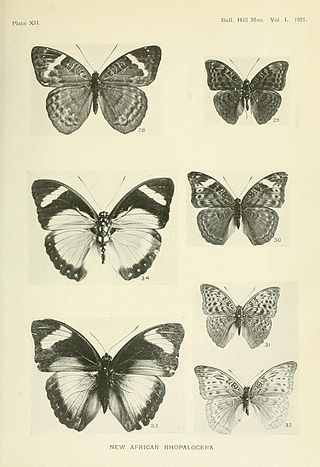
Danainae is a subfamily of the family Nymphalidae, the brush-footed butterflies. It includes the Daniadae, or milkweed butterflies, who lay their eggs on various milkweeds on which their larvae (caterpillars) feed, as well as the clearwing butterflies (Ithomiini), and the tellervini.

The Nymphalidae are the largest family of butterflies, with more than 6,000 species distributed throughout most of the world. Belonging to the superfamily Papilionoidea, they are usually medium-sized to large butterflies. Most species have a reduced pair of forelegs and many hold their colourful wings flat when resting. They are also called brush-footed butterflies or four-footed butterflies, because they are known to stand on only four legs while the other two are curled up; in some species, these forelegs have a brush-like set of hairs, which gives this family its other common name. Many species are brightly coloured and include popular species such as the emperors, monarch butterfly, admirals, tortoiseshells, and fritillaries. However, the under wings are, in contrast, often dull and in some species look remarkably like dead leaves, or are much paler, producing a cryptic effect that helps the butterflies blend into their surroundings.

The morpho butterflies comprise many species of Neotropical butterfly under the genus Morpho. This genus includes more than 29 accepted species and 147 accepted subspecies, found mostly in South America, Mexico, and Central America. Morpho wingspans range from 7.5 cm (3.0 in) for M. rhodopteron to 20 cm (7.9 in) for M. hecuba, the imposing sunset morpho. The name morpho, meaning "changed" or "modified", is also an epithet. Blue morphos are severely threatened by the deforestation of tropical forests and habitat fragmentation. Humans provide a direct threat to this genus because their beauty attracts artists and collectors from all over the globe who wish to capture and display them. Aside from humans, birds like the jacamar and flycatcher are the adult butterfly’s natural predators.

A proboscis is an elongated appendage from the head of an animal, either a vertebrate or an invertebrate. In invertebrates, the term usually refers to tubular mouthparts used for feeding and sucking. In vertebrates, a proboscis is an elongated nose or snout.

The superfamily Papilionoidea contains all the butterflies except for the moth-like Hedyloidea.

The Nymphalinae are a subfamily of brush-footed butterflies. Sometimes, the subfamilies Limenitidinae, and Biblidinae are included here as subordinate tribe(s), while the tribe Melitaeini is occasionally regarded as a distinct subfamily. Their phylogenetics can be traced back to the Cretaceous Terrestrial Revolution after the Cretaceous-Paleogene (K-Pg) mass extinction, followed by repeated dispersals into the rest of the Old World and the New World during various periods beginning in the Eocene.

The Satyrinae, the satyrines or satyrids, commonly known as the browns, are a subfamily of the Nymphalidae. They were formerly considered a distinct family, Satyridae. This group contains nearly half of the known diversity of brush-footed butterflies. The true number of the Satyrinae species is estimated to exceed 2,400.

The Satyrini is one of the tribes of the subfamily Satyrinae. It includes about 2200 species and is therefore the largest tribe in the subfamily which comprises 2500 species.

Biblidinae is a subfamily of nymphalid butterflies that includes the tropical brushfoots. This subfamily was sometimes merged within the Limenitidinae, but they are now recognized as quite distinct lineages. In older literature, this subfamily is sometimes called Eurytelinae.

The butterfly subtribe Euptychiina is a diverse group within the tribe Satyrini, occurring throughout Central and South America, in addition to a few species known from North America. Euptychiina is a predominantly lowland group, with the exception of one Asian taxon Palaeonympha opalinaButler, 1871 and the Andean genus ForsterinariaGray, 1973. The taxon was erected by Lee Denmar Miller.
Anthene contrastata, the mashuna hairtail, is a butterfly of the family Lycaenidae. It is found in eastern Africa, from South Africa, north to Ethiopia and Arabia.

Protogoniomorpha anacardii, the clouded mother-of-pearl, is a species of Nymphalidae butterfly found in tropical Africa, and in Arabia

Mashuna is a butterfly genus from the subfamily Satyrinae in the family Nymphalidae.

Mashuna mashuna, the Mashuna ringlet, is a butterfly in the family Nymphalidae. It is found in Zimbabwe. The habitat consists of marshy areas in savanna and grassland.

Neocoenyra duplex is a butterfly in the family Nymphalidae. It is found in southern Ethiopia, Somalia, Kenya, Uganda, Rwanda, the eastern part of the Democratic Republic of the Congo and northern Tanzania. The habitat consists of grassy savanna.
Neocoenyra fuligo is a butterfly in the family Nymphalidae. It is found in central Tanzania. The habitat consists of montane grassland at altitudes between 2,000 and 2,100 meters.

Neocoenyra fulleborni is a butterfly in the family Nymphalidae. It is found in southern Tanzania. The habitat consists of submontane and montane grassland and shrubland at altitudes between 1,500 and 1,800 meters.

Euphaedra nigrobasalis is a butterfly in the family Nymphalidae. It is found in the Democratic Republic of the Congo, Zambia and Malawi. The habitat consists of primary forests.
Lepidochrysops mashuna, the mashuna blue, is a butterfly in the family Lycaenidae. It is found in Zimbabwe. Their habitat consists of grassy areas in savanna. Adults feed from flowers. They are on wing from October to December.

Anaea are a genus of charaxine butterflies in the brush-footed butterfly family Nymphalidae. The butterflies are commonly known as leafwings. Members of the genus are found throughout the United States, Central America, and the Caribbean.















